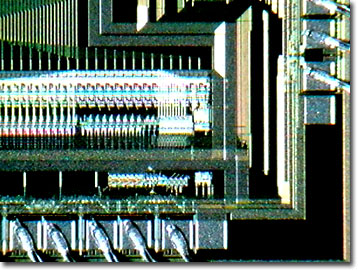Integrated Circuit Image Gallery
Texas Instruments 486DX Microprocessor
In 1989, the 32-bit 80486 heralded the fourth generation of microprocessors with two radical innovations: the integration of a floating-point unit along with the processor and the addition of an internal 8-Kbyte memory cache. With 1.2 million transistors on an 81-square millimeter silicon die, the 486 chip was created with 1.0-micron complementary metal oxide semiconductor (CMOS) technology. This microprocessor took the world's personal computer markets by storm, and was issued by the designer, Intel, and licensed manufacturers such as Texas Instruments, IBM, Advanced Micro Devices, and Cyrix.

View a low magnification image of the TI486DX processor.
View a high magnification image of the TI486DX processor.
The 486 processor initially had a clock speed of 25 MHz and a 5-volt power requirement. There are many subsequent models of the 486 processor, some including clock doubling and tripling, and embedded and low-power versions, making the family much larger than the previous 386 corps.
Texas Instruments released a 486 microprocessor clone in 1992. As with other licensed look-alikes, the Texas Instruments 486 chip is virtually identical to Intel's original design. Although largely obsolete in the personal computer market, TI486s are featured as on-board processors for modern electronics equipment such as data acquisition processors and in embedded applications with improved cache memories, clock speeds, and lower power requirements. As with its 386 predecessor, this CPU received a "DX" designation after the release of the less expensive and less powerful 486SX chip.
Contributing Authors
Omar Alvarado, Thomas J. Fellers and Michael W. Davidson - National High Magnetic Field Laboratory, 1800 East Paul Dirac Dr., The Florida State University, Tallahassee, Florida, 32310.
BACK TO THE INTEGRATED CIRCUIT IMAGE GALLERY
BACK TO THE DIGITAL IMAGE GALLERIES
Questions or comments? Send us an email.
© 1995-2025 by Michael W. Davidson and The Florida State University. All Rights Reserved. No images, graphics, software, scripts, or applets may be reproduced or used in any manner without permission from the copyright holders. Use of this website means you agree to all of the Legal Terms and Conditions set forth by the owners.
This website is maintained by our
Graphics & Web Programming Team
in collaboration with Optical Microscopy at the
National High Magnetic Field Laboratory.
Last Modification Friday, Nov 13, 2015 at 01:19 PM
Access Count Since September 17, 2002: 7543
Visit the website of our partner in introductory microscopy education:
|
|
